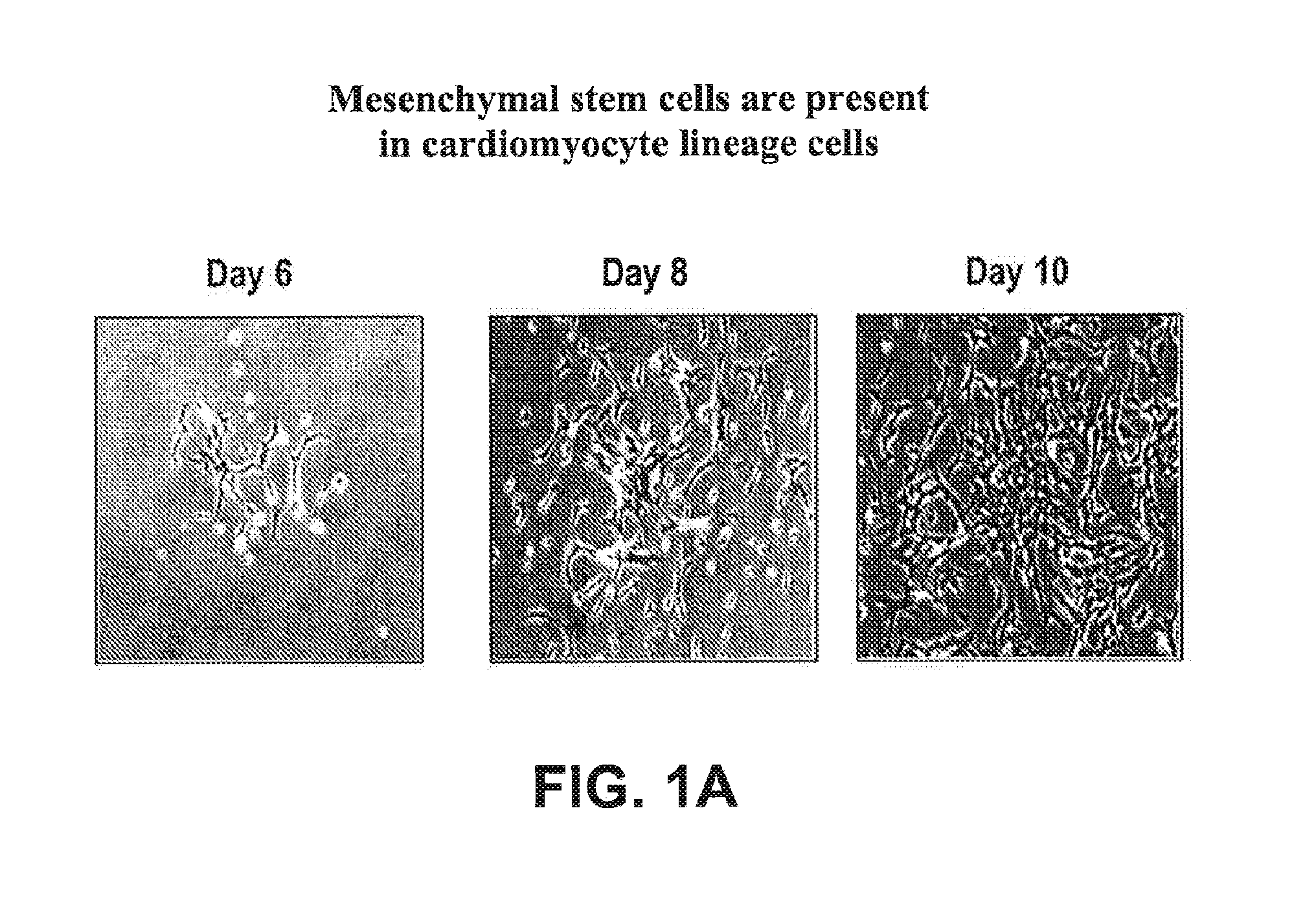Enriched populations of cardiomyocyte lineage cells from pluripotent stem cells
a technology of pluripotent stem cells and cardiomyocytes, applied in the field of stem cell biology, can solve the problems of reducing the overall efficacy of cell preparation, and achieve the effects of better screening agents, better therapeutic agents, and better research agents
- Summary
- Abstract
- Description
- Claims
- Application Information
AI Technical Summary
Benefits of technology
Problems solved by technology
Method used
Image
Examples
example 1
Mesenchymal Stem Cells are Present in Cardiomyocyte Lineage Cells Differentiated In Vitro from hES Cells
[0319]Mesenchymal stem cells (MSCs) are multipotent cells that possess a unique capacity to differentiate into specific cell types. The identification and characterization of MSCs are generally characterized using three parameters: 1) Adherence to plastic under standard culture conditions; 2) Cell surface expression of CD73, CD90, and CD105; and 3) In vitro differentiation into osteoblasts, chondrocytes, or adipocytes. These parameters were used to evaluate for the presence of MSCs in a preparation of cardiomyocyte lineage cells which were obtained by the in vitro differentiation of human embryonic stem cells.
[0320]For the initial identification of MSCs in the cardiomyocyte lineage cell preparation, adherence culture methods were utilized. Cardiomyocyte lineage cells were added to 6-well standard tissue culture plates (Corning Life Sciences, Corning, NY) containing MSC maintenance...
example ii
Depletion of CD90 Positive Cells Using Indirect Isolation Depletes MSCs from Cardiomyocyte Lineage Cells Differentiated In Vitro from hES Cells
[0323]CD90, a marker expressed by MSCs, was used as a target antigen for depletion of MSCs from cardiomyocyte lineage cells differentiated in vitro from hES cells. To deplete CD90+ cells from the cardiomyocyte lineage cells, the Miltenyi microbead system was utilized (Miltenyi Biotec, Auburn, Calif.). The cardiomyocyte lineage cells were resuspended in depletion buffer (PBS+0.5% BSA+2 mM EDTA) and mouse anti-human CD90 antibody conjugated to PE, (10 μl / 1e6 cells) (BD Biosciences, San Jose, Calif.) at a final cell concentration of 4e7 cells / mL. Cells were incubated with the antibody for 20 minutes at 4° C. and then washed 1× and resuspended with depletion buffer at 1e7 cells / 80 μL. Following the manufacturer's instructions, anti-PE micro beads (Miltenyi Biotec, Auburn, Calif.) were added to the cells at 20 μL per 1e7 cells. Cells were incubate...
example iii
Depletion of CD90 Positive Cells Using Direct Isolation Depletes MSCs from Cardiomyocyte Lineage Cells Differentiated In Vitro from hES Cells
[0327]CD90 positive cells were depleted from a preparation of cardiomyocyte lineage cells differentiated in vitro from an established line of human embryonic stem cells using the DynaBead® (Invitrogen, Carlsbad, Calif.) magnetic separation system and removal of MSCs was evaluated. Following the manufacturer's protocol, the direct cell isolation method was utilized. Unconjugated Mouse anti-CD90 antibody at 0.5 μg (Biolegend, San Diego, Calif.) was added to 25 μL (1e7 beads) of DynaBead® Pan Mouse IgG (Invitrogen, Carlsbad, Calif.), and incubated for 30 minutes at room temperature with gentle mixing. The tube containing the antibody mixture was placed in a magnet (Invitrogen, Carlsbad, Calif.) for 1 minute, supernatant was discarded, and the bead mixture was washed 2× with depletion buffer (0.1% BSA+1× PBS). The bead mixture was resuspended in de...
PUM
| Property | Measurement | Unit |
|---|---|---|
| volume | aaaaa | aaaaa |
| volume | aaaaa | aaaaa |
| volume | aaaaa | aaaaa |
Abstract
Description
Claims
Application Information
 Login to View More
Login to View More - R&D
- Intellectual Property
- Life Sciences
- Materials
- Tech Scout
- Unparalleled Data Quality
- Higher Quality Content
- 60% Fewer Hallucinations
Browse by: Latest US Patents, China's latest patents, Technical Efficacy Thesaurus, Application Domain, Technology Topic, Popular Technical Reports.
© 2025 PatSnap. All rights reserved.Legal|Privacy policy|Modern Slavery Act Transparency Statement|Sitemap|About US| Contact US: help@patsnap.com



